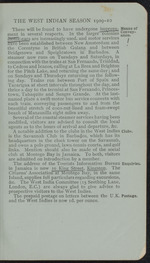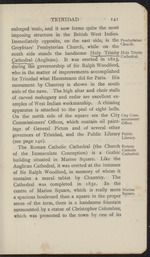| 1 |
 |
“...THE WEST INDIAN SEASON 1909-10
These will be found to have undergone improve- Means of
ment in several respects. In the larger colonies ance.Cy”
lilUtur-cars are increasingly used, and motor services .
nave been established between New Amsterdam and ƒ
the Corentyne in British Guiana and between
Bridgetown and Speightstown in Barbados. A
steamer now runs on Tuesdays and Saturdays, in
connection with the trains at San Fernando, Trinidad,
to Cedros and Icacos, calling at La Brea and Brighton
for the Pitch Lake, and returning the same day; and
on Sundays and Thursdays returning on the follow-
ing day. Trains run between Port of Spain and
Tacarigua at short intervals throughout the day, and
thrice a day to the termini at San Fernando, Princes-
town, Tabaquite and Sangre Grande. At the last-
named place a swift motor bus service connects with
each train, conveying passengers to and from the
beautiful stretch of coco-nut-lined and fóam-swept
beach of Manzanilla eight Piiles away.
Several of the...”
|
|
| 2 |
 |
“...quite the most
imposing structure in the British West Indies.
Immediately opposite, on the east side, is the Presbyterian
Greyfriars’ Presbyterian Church, while on the 1110 '
south side stands the handsome Holy Trinity Holy Trinity
, _ ‘ , . 0 1 Cathedral.
Cathedral (Anglican). It was erected in 1823,
during the governorship of Sir Ralph Woodford,
who in the matter of improvements accomplished
for Trinidad what Haussmann did for Paris. His
monument by Chantrey is shown in the south
aisle of the nave. The high altar and choir stalls
of carved mahogany and cedar are excellent ex-
amples of West Indian workmanship. A chiming
apparatus is attached to the peal of eight bells.
On the north side of the square are the City City C°ra-
Commissioners’ Offices, which contain oil paint- office,
ings of General Picton and of several other
governors of Trinidad, and the Public Library Public
° . Library.
(see page 140).
The Roman Catholic Cathedral (the Church Roman^
of the Immaculate Conception) is a Gothic...”
|
|
